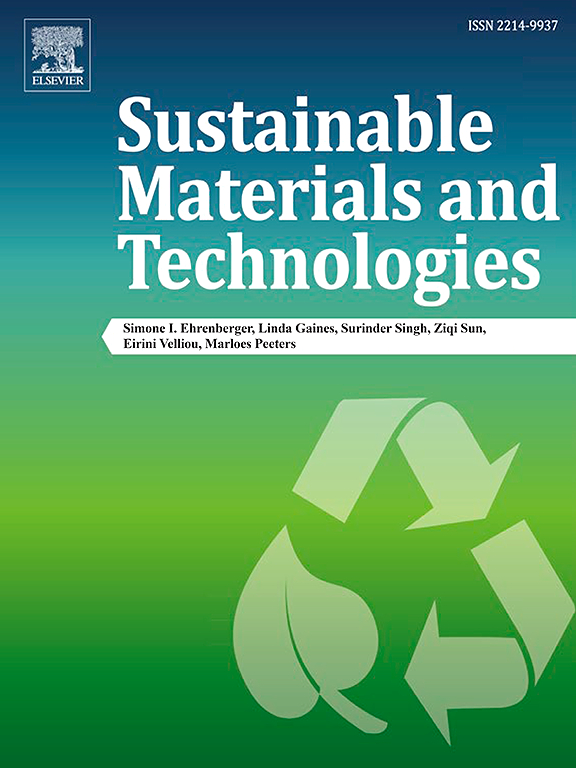Assessing the environmental impact of cryogenic treatment in recycling scenarios for PBT-GF30 components
IF 8.6
2区 工程技术
Q1 ENERGY & FUELS
引用次数: 0
Abstract
Glass-Fiber-Reinforced-Polymers (GFRP) have a considerable environmental impact. For companies that produce automotive products, this can be an issue, due to the current need to comply with EU sustainable goals. The environmental impact of the GFRP, that includes PBT-GF30, increases when products incorporate other material, such as metallic screws. When the products come out defective from the manufacturing, the complete segregation between metal and plastic is complex. Therefore, the product EoL is usually the landfill and the lack of their recyclability raised an environmental concern. To overcome this environmental issue, this study pointed out Cryogenic Treatment (CT) as a technique to fragilize the GFRP, improving the recycling process in two ways: materials segregation and decreased energy for plastic's shredding. To conduct the analysis, PBT-GF30 samples, with and without screws, were subjected to CT and impact tests and afterwards a mechanical characterization was performed, confirming the variation of tensile strength. To complement the study, LCA and LCC was conducted for three scenarios of disposal of the defective parts – landfill; mechanical recycling; and CT before mechanical recycling, in order to characterize the environmental impact of the proposed solution compared to the current one, landfill. Results highlight that CT and impact lowered the PBT-GF30 stress at break by 30 %, requiring less energy by the same amount to break the material in the shredding process. The analysis identified the landfill scenario (baseline) as having the highest environmental impact, primarily due to the absence of material recovery, which increases the demand for raw materials, increasing extraction-related impacts. In contrast, recycling methods significantly reduced these burdens. CT before mechanical recycling, for instance, demonstrated a potential 30 % reduction in environmental impacts by reintegrating recycled materials into production processes, highlighting its potential to enhance sustainability. However, the high cost associated with liquid nitrogen production could be a limitation. Nonetheless, CT before mechanical recycling offers approximately 30 % lower costs than the baseline when viewed through a circular economy perspective, presenting a balanced approach to improving environmental and economic outcomes.
评估低温处理在PBT-GF30组件回收方案中的环境影响
玻璃纤维增强聚合物(GFRP)具有相当大的环境影响。对于生产汽车产品的公司来说,这可能是一个问题,因为目前需要遵守欧盟的可持续发展目标。GFRP(包括PBT-GF30)对环境的影响在产品中加入其他材料(如金属螺钉)时会增加。当生产出来的产品有缺陷时,金属和塑料之间的完全分离是很复杂的。因此,产品EoL通常被填埋,缺乏可回收性,引起了环境问题。为了克服这一环境问题,本研究指出低温处理(CT)作为GFRP的脆弱技术,从两个方面改进回收过程:材料分离和减少塑料切碎的能量。为了进行分析,对带螺钉和不带螺钉的PBT-GF30样品进行了CT和冲击试验,然后进行了力学表征,确认了抗拉强度的变化。为配合研究,我们进行了三种处置残缺部分的方案:堆填;机械回收;和机械回收前的CT,以表征所提出的解决方案与目前的填埋方案相比对环境的影响。结果表明,CT和冲击使PBT-GF30在断裂时的应力降低了30%,在粉碎过程中需要较少的能量来破坏材料。分析指出,填埋情景(基线)对环境的影响最大,主要是由于没有材料回收,这增加了对原材料的需求,增加了与提取有关的影响。相比之下,回收方法大大减轻了这些负担。例如,在机械回收之前的CT技术,通过将回收材料重新整合到生产过程中,可以减少30%的环境影响,突出了其提高可持续性的潜力。然而,与液氮生产相关的高成本可能是一个限制。尽管如此,从循环经济的角度来看,机械回收前的CT比基线成本低约30%,呈现出一种改善环境和经济结果的平衡方法。
本文章由计算机程序翻译,如有差异,请以英文原文为准。
求助全文
约1分钟内获得全文
求助全文
来源期刊

Sustainable Materials and Technologies
Energy-Renewable Energy, Sustainability and the Environment
CiteScore
13.40
自引率
4.20%
发文量
158
审稿时长
45 days
期刊介绍:
Sustainable Materials and Technologies (SM&T), an international, cross-disciplinary, fully open access journal published by Elsevier, focuses on original full-length research articles and reviews. It covers applied or fundamental science of nano-, micro-, meso-, and macro-scale aspects of materials and technologies for sustainable development. SM&T gives special attention to contributions that bridge the knowledge gap between materials and system designs.
 求助内容:
求助内容: 应助结果提醒方式:
应助结果提醒方式:


